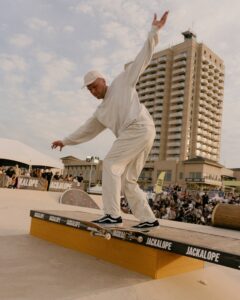1- Sport and fashion, a timeless influence
Sports have always influenced fashion. From the iconic Vans shoes worn by 80s skateboarders to the 90s tracksuits inspired by jogging, sporty style has left its mark on generations. Originally, these clothes served practical purposes: non-slip soles for skateboarding, loose cuts for freedom of movement while snowboarding. But quickly, these pieces went beyond their original function to become symbols of rebellion and style. Today, there are more Vans on the street than skateboarders in parks, proving that their lifestyle inspires everyone.

The phenomenon has continued to evolve. While in the past, consumers adopted sports-inspired clothing to “look cool,” today, luxury brands actively seek to claim the authenticity and aesthetics of sports that were once marginalized. Athletes have become cultural influencers, often at the heart of an intersection between sport, fashion, and marketing. From the field to the catwalk, the boundary between sport and fashion is gradually disappearing: what triggered this rapprochement? Why are athletes now the new style icons in the fashion world?
____________
2- Athletes and influence: when authenticity becomes a marketing asset
In action sports like skateboarding or snowboarding, athletes are not just competitors: they are cultural icons, fashion leaders, and they have undeniable influence over their followers. Their authenticity and closeness to their communities give them immense credibility, the holy grail for successful brand communication.
Voir cette publication sur Instagram
Take Nyjah Huston, an iconic skateboarder who collaborates with Nike SB (shoes specifically designed for skateboarding) and appears in fashion campaigns. Or Rayssa Leal, a young Brazilian skateboarder, who has won the global audience not only with her performances but also with her unique style.
Voir cette publication sur Instagram
These collaborations transcend sport, providing brands with a gateway to a young, dynamic, and connected audience. It’s even becoming common to see sports crossovers to maximize a brand’s reach. The Nyjah Huston X LeBron James X Nike collaboration is a great example of this.
Voir cette publication sur Instagram
Giants like Nike and Adidas have not only democratized skateboarding and snowboarding but have also redefined the perception of these sports. By supporting talents like Sky Brown, they have, in turn, gained a kind of “cultural pass” to these disciplines. Sky, for example, combines exceptional performance with fashion influence through partnerships with Adidas and Vans, while also sharing values of inclusivity and empowerment.
3- From the streets to the catwalks: the rise of alternative sports in luxury
It was only a matter of time before luxury brands saw a golden opportunity. From snowparks and skateparks to high fashion catwalks, sports once considered marginal now have a prime spot in the luxury world, just like certain music cultures such as hip hop or punk rock. Skateboarding, snowboarding, and freeskiing, once symbols of urban and rebellious cultures, have influenced prestigious collections and high-end brand accessories like Louis Vuitton and Dior, to name a few. This echoes Prada’s launch of a snowboard line for the 2022 Winter Olympics, highlighting the rise of action sports in the luxury world—a move we will revisit as a potential misstep.
Voir cette publication sur Instagram
Eileen Gu, freestyle skier and double Olympic gold medalist, perfectly embodies this fusion with her 2 million followers. A brand ambassador for Louis Vuitton, Tiffany & Co., and Porsche, she is redefining the codes of influence by combining athletic performance, female empowerment, and style. At just 20 years old, she represents a role model for a connected generation in search of authenticity, in addition to being one of the highest-paid female athletes, with earnings estimated at $22.1 million—no less.
Voir cette publication sur Instagram
But this transition to luxury is not without risks. As previously mentioned, during the 2022 Winter Olympics, American snowboarder Julia Marino had to remove the Prada logo from her snowboard, as it was deemed too large by the International Olympic Committee (IOC). Forcing an athlete to alter her equipment just before a competition not only sparked criticism of the IOC’s strict rules but also highlighted the challenges of a poorly thought-out collaboration. Brands must respect the essence of the sport and avoid exploiting popular sports. Collaboration is not just about slapping a logo on a product.
4- From lifestyle to marketing: athletes as amplifiers of sports culture
Modern athletes don’t just sell performances; they embody a lifestyle. Vans sneakers, originally designed for skateboarding, are now ubiquitous, far beyond skateparks. This phenomenon demonstrates how these sports inspire a broader culture. For brands, investing in these athletes means ensuring authentic cultural relevance while reaching a wider demographic. Digital platforms amplify this influence. Instagram, TikTok, YouTube, and even Twitch have become essential channels for athletes, allowing them to create personalized content, interact directly with their communities, and convey messages that go beyond simple product promotion. This gives brands direct access to precise, engaged, and often very young audiences who no longer simply consume products, but stories they can relate to.
Voir cette publication sur Instagram
Collaborations no longer just involve logos on equipment; they now include shared stories on social media, behind-the-scenes videos, and captivating advertising campaigns. Events like the Olympics, X-Games, World Championships, or JACKALOPE have become global showcases where athletes, through their digital activity, amplify the media reach of brands.
____________
From asphalt to catwalk: a story of authenticity
The evolution of sport in fashion illustrates a dynamic where values, creativity, and authenticity are at the core of collaborations. Brands must partner with specialists and respect the identity of the sports to remain relevant. Far from being just disciplines, skateboarding, snowboarding, and other action sports have become catalysts for style and communities, reaching millions of people.
Our events are not just competitions: they are platforms where every athlete, whether a micro or macro-influencer, creates high-impact content. Their online presence and community engagement amplify the visibility of brand partners well beyond traditional audiences.
The message is clear: investing in these athletes and their lifestyle is about embedding yourself in a dynamic, inclusive, and future-focused culture.